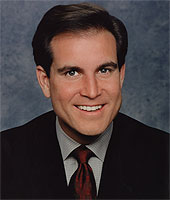 Since he was 11 years old growing up in Colts Neck, N.J., Jim Nantz wanted to broadcast for CBS. At 26, he found himself broadcasting live for CBS Sports and 25 years later he is the pinnacle of sports broadcasting. He is living what he calls a wonderful life and is grateful for the opportunities that CBS has given him over his career, in lieu of being a sports anchor with highlight packages.
Since he was 11 years old growing up in Colts Neck, N.J., Jim Nantz wanted to broadcast for CBS. At 26, he found himself broadcasting live for CBS Sports and 25 years later he is the pinnacle of sports broadcasting. He is living what he calls a wonderful life and is grateful for the opportunities that CBS has given him over his career, in lieu of being a sports anchor with highlight packages.
"It's [sports anchoring] not like being able to call a Super Bowl or The Masters. One guy gets to call that," Nantz said.
Nantz got his start in broadcasting through radio. He called basketball games at the University of Houston when he was a student there. Nantz says that his start in radio was crucial to his success.
"Radio training was very viable to my career in getting started and getting comfortable with the pacing and rhythm of calling games," Nantz said.
Now the lead play-by-play broadcaster for CBS, Nantz appreciates the subtleties between radio and television mediums. While admitting it took a certain talent to do radio play-by-play, he prefers the visual partnership television offers.There is a fine line between saying too much to the point of insulting the viewer or being to spare and not providing enough information he said.
However, Nantz stressed that when you do talk, journalists must make their words count. Nantz even related this to writing in print.
"If you have a chance to say it succinctly, those words that you have say it with tremendous punch," the Emmy-winning broadcaster said.
Nantz believes that some announcers have their judgment clouded during games and try to utilize the game as a stage to show off their humor or sense of recall. It is Nantz's belief that it is his job to not just make the viewing experience more pleasurable for the guy on the couch, but to observe and inform what is going on at the sporting event.
In addition, he also has the ability to put a headline on the game so the viewer comes away with more than just the final score. Nantz set up a situation where the New England Patriots beat the San Diego Chargers.
Nantz said he only scratches the surface of all the information he compiles from players to present as stories during the course of a game. However, the news he gathers he stores away and uses it like a database for later games when "stories find their home."
Live television is arguably the hardest medium to perform in the field of journalism. But Nantz makes it look effortless every Sunday during the NFL regular season, during the highs and lows of the NCAA March Madness tournament and The Masters.
"It's really gratifying when you walk out of the booth and you know that everyone felt like they did their best," Nantz said.
.jpg)


